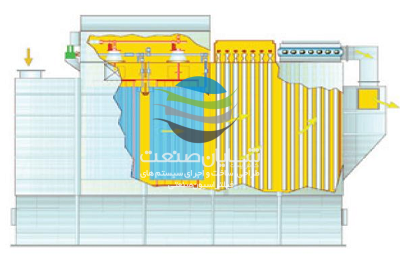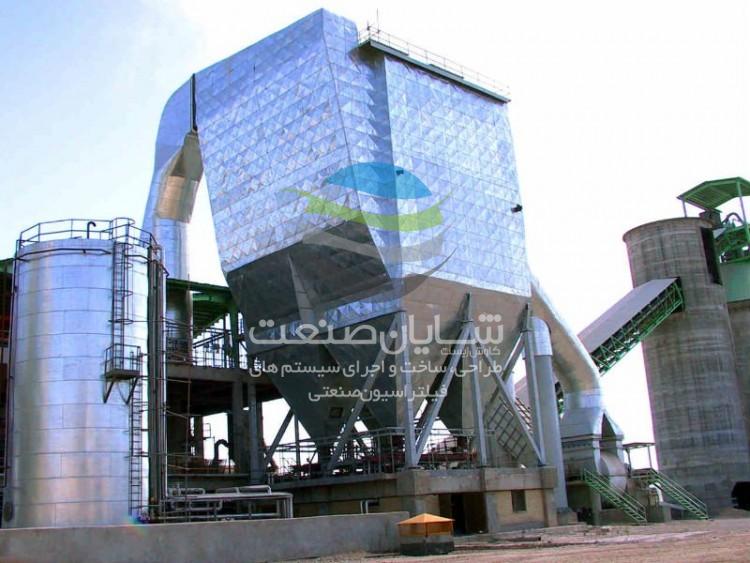Converting Electric Filters to Hybrid Filters – Part One
In an effort to achieve optimal filtration efficiency for different operating conditions, hybrid filters were introduced as a new technology and a suitable solution for separating dust from gas in the mining and cement industries.
Hybrid filters can be used for furnaces, coolers, cement mills, coal mills and return streams. FL Smith has provided more than 20 hybrid filters for this equipment.
Hybrid filter design:
The hybrid filter can be designed in two different ways:
- Install a fabric filter after an existing electrofilter.
- Install a fabric filter and an electrofilter in a chamber.
In the first case, the electrofilter and the fabric filter are two completely separate parts that are connected by a duct. In the second case, the electrofilter housing and its electrical parts are kept and some of its end parts are removed and replaced by a fabric filter.

In both cases, the electrofilter captures dust and large particles, and the fabric filter is responsible for removing the soft part of the dust. In this paper, the conversion of an electrofilter to a hybrid filter in a chamber is investigated.
General considerations for converting electrofilters to hybrid filters:
The following should be considered when upgrading an air pollution control unit due to environmental considerations:
- Investment cost
- Operating costs
- Availability of equipment
- Maintenance capability
- Production unit space
- Mechanical condition of existing electrofilter and dust transfer system
- Fan capacity and transmission ducts
- Process needs and fuel used
According to the above, there are several steps to upgrade a filter and the optimal solution depends on the ability to recognize the needs of the factory, customer requests and the ability to estimate the disadvantages and advantages of this upgrade for the factory.
The table below shows a comparison of fabric filters and electrofilters. According to the conditions of each filter and the needs of the factory, the appropriate filter can be selected.
| Electrofilter | Cloth filter | Variable | |
| 25 | 120-150 | Normal | MmWG pressure drop |
| 75-100 | hybrid | ||
| Maximum 5 | Less than 5 | Exhaust dust ( 3 (mg / Nm | |
| Medium to high | Low | Sensitivity of output dust to process variables | |
| 400 | 240-260 | Tolerable temperature (C °) | |
| Much | Low | Explosion risk | |
| Low | Much | Fire risk | |
| No | Yes | Complete filtration | |
| Bottom – Outline | Top-inline | Repair capability | |
| 4 years | 4 years | Bags | Service time |
| 8 years | Container | ||
Advantages of filter conversion compared to building a new filter:
The conversion of electrofilters into hybrid filters has several advantages, both in terms of dust emitted from the filter and in terms of investment and operating costs:
- Efficiency: The dust from the hybrid filter is usually not much less than the electrofilter. The hybrid filter also dusts when the electrofilter fails.
- Investment cost: Investment cost less than the new fabric filter due to the reuse of the structure, dust transfer system and control system, as well as higher power consumption than the fabric filter instead of consuming less fabric.
- Operating costs: Dust separation in the first part electrofilter reduces the need to clean the fabric filters of the second part in the hybrid filter, which reduces the cost of compressed air for cleaning the fabrics.
The cost of electricity for a rectifier and an electrofilter fan is usually less than the cost of electricity for a conventional bag filter fan. However, the drawbacks and consequences of converting an electrofilter to a hybrid filter should be considered, including:
- Maintenance of modern pitcher filters for raw material mill filters is usually inline, while hybrid filters such as electrofilters work offline.
- The electrophoretic part of the hybrid filter absorbs most of the dust and the very soft part of the dust goes to the fabric filter. This very soft dust causes a very hard cake on the fabric filter due to the uniform density of the soft dust.

